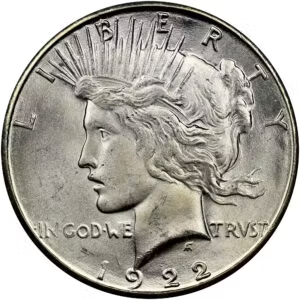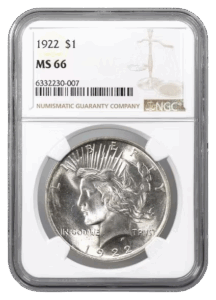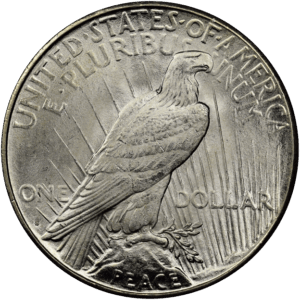1922 Silver Dollar Value: What it’s Worth and Why
Posted on — 1 CommentFew coins can claim to embody peace and historical triumph quite like the Peace dollar. Aptly named to honor America’s victory and the restoration of global peace after World War I, this iconic coin was first issued in 1921. The following year saw the Peace dollar reach its production pinnacle with over 84 million coins minted. Today, collectors and investors recognize 1922 as a pivotal year, marking the Peace dollar’s transition from symbolic debut to widespread circulation. This article explains what determines 1922 silver dollar value, how to identify key features, and what to look for when evaluating your coin.
What is the value of a 1922 Peace Silver Dollar: Background and History
The 1922 Peace dollar marked a key shift in American coinage, shaped by wartime policy, public pushback, and design challenges that led to distinctive varieties and enduring collector interest.
Historical Context and Design
The Peace dollar’s origins trace back to World War I and the Pittman Act of 1918. When Britain needed silver to stabilize currency in India and counter German destabilization efforts, Congress authorized melting over 270 million Morgan silver dollars to sell the metal to Britain. The Pittman Act required the Treasury to eventually replace these melted coins with new silver dollars struck from domestically mined silver.
By 1921, the Mint began fulfilling this requirement using the old Morgan dollar design. However, numismatists led by Frank Duffield and Farran Zerbe had been lobbying since 1918 for a new design commemorating America’s victory and the peace that followed. Their persistence paid off when they convinced Treasury officials that a peace-themed coin would be both appropriate and popular, symbolizing America’s hope for lasting peace after WWI. The Treasury announced a design competition in late 1921, inviting established sculptors including previous U.S. coin designers. Anthony de Francisci, at 34 the youngest competitor, won unanimously with his design featuring Liberty modeled after his wife Teresa.

Image: Lady Liberty’s profile on the Peace dollar.
Source: NGC
However, controversy over the design erupted almost immediately. De Francisci’s original reverse design included a broken sword beneath the eagle, symbolizing the end of war. When news leaked to the public, newspapers like the New York Herald attacked the imagery, arguing that a broken sword represented defeat, not victory.
Under intense pressure, Treasury officials hastily ordered the sword removed just days before the scheduled December 28, 1921 first strike. Chief Engraver George Morgan used extremely fine engraving tools to carefully carve the sword from the existing coinage hub, extending the olive branch to cover the modification. Morgan’s precision work was so skillful that numismatists didn’t discover this hand-engraving technique until over 85 years later, having assumed the Mint had created entirely new dies. It’s this level of craftsmanship and historical intrigue that has led some examples to be considered the “holy grail” of Peace dollars.
To see how 1922 Peace silver dollar value can skyrocket for rare examples, watch this nationally televised appraisal.
Mint Mark Variations and Rarity
1922 silver dollar value largely depends on where it was minted, with each facility producing coins bearing distinct characteristics:
Philadelphia Mint (no mint mark)
The Philadelphia facility produced approximately 51.7 million coins, making these the most common 1922 Peace dollars. While abundant, 1922 silver dollar value (no mint mark) can be significant for exceptional examples in high grades.
Image: A high-grade example of a Philadelphia Mint 1922 Peace silver dollar, certified MS66 by NGC.
Source: Blanchard Gold
Denver Mint (“D” mint mark)
The Denver Mint struck roughly 15.1 million pieces, making the 1922-D considerably scarcer than Philadelphia issues. As such, 1922 D silver dollar value is typically higher than the more common Philadelphia examples. Denver coins often exhibit weaker strikes due to die spacing issues, making well-struck examples particularly valuable. The “D” mint mark appears on the reverse below the eagle.
San Francisco Mint (“S” mint mark)
San Francisco produced about 17.5 million coins, falling between Philadelphia and Denver in terms of rarity. Despite this middle position in mintage numbers, 1922 S silver dollar value often surprises collectors because San Francisco coins are notorious for weak strikes and bagmarks from rough handling during transport and storage, making pristine examples exceptionally rare and valuable.
These production differences create a clear rarity hierarchy that directly impacts modern 1922 silver dollar value, with Denver and San Francisco examples typically commanding higher prices than their Philadelphia counterparts.
Enduring Market Appeal
The 1922 silver dollar continues to attract both collectors and investors for several reasons. Firstly, its role in commemorating post-World War I peace gives it strong historical appeal. Secondly, its substantial silver content offers intrinsic value tied to precious metals markets. Moreover, its accessibility makes it a popular starting point for new collectors, while seasoned numismatists can seek out high-grade examples and elusive varieties. This blend of historical significance, bullion value, and varying scarcity across mint marks ensures enduring demand.
What Determines 1922 Silver Dollar Value Today?
What a 1922 silver dollar is worth comes down to a mix of condition, mint mark, scarcity, and silver prices. Common examples are valued under $50, but rare varieties and top-grade coins can command five figures.
Condition and Grading Impact on Price
Condition plays a critical role in the value of a 1922 silver dollar, with even slight differences in grade leading to dramatic price variations. Heavily circulated examples in Very Fine condition typically trade near bullion value, while Mint State coins in the MS-63 range command modest premiums. The real appreciation begins at MS-65, where prices increase substantially, and MS-66 examples can reach four-figure values. MS-67 1922 Peace dollars are considered extreme condition rarities, with documented auction sales demonstrating their significant collector premium over lower grades. Learn how professional grading affects the value and collectibility of coins like the 1922 silver dollar.
Mint Mark Influence on Value
As mentioned previously, mint marks create clear value hierarchies. Philadelphia coins (no mint mark) remain most affordable due to their 51.7 million mintage. Denver “D” examples typically sell for 25-50% premiums over Philadelphia coins in similar grades, while San Francisco “S” coins command even higher premiums due to their notorious quality issues, making high-grade examples genuinely scarce.
Special Varieties and Error Coins
Beyond grading and mint marks, certain varieties and errors of the 1922 silver dollar carry substantial premiums due to their rarity and visual distinctiveness. These minting anomalies, caused by production issues such as die cracks and breaks, are highly sought after by advanced collectors. One such example is the “Die Break in Reverse Field,” marked by a noticeable blob of raised metal beneath the eagle, clearly visible without magnification. Another is the so-called “Ear Ring” variety, where a die crack creates a striking metal arc across Liberty’s ear. Even more valuable are high-relief strikes from early 1922 production, issued before the Mint lowered the relief for mass production. When authenticated, these coins can greatly increase the value of a 1922 silver dollar. 
Image Description: The highly recognizable and sought-after variety “Ear Ring” 1922 Peace silver dollar variety.
Source: PCGS
Current Market Trends
Silver content also plays a fundamental role in 1922 Peace dollar values, as each coin contains roughly 0.77 ounces of silver. When silver trades at $25 per ounce, the coin’s melt value alone approaches $20. However, 1922 silver dollar value today extends beyond bullion prices: collector demand, interest in certified high-grade coins, and increased recognition of rare varieties all contribute to upward pressure on values.
How to Assess 1922 Peace Silver Dollar Value
Identifying a valuable 1922 silver dollar means looking beyond the date. It involves carefully checking design details, spotting known counterfeits, and knowing when expert authentication is worth the investment.
Checking Key Features and Mint Marks
Evaluating 1922 Peace silver dollar value starts with examining a coin’s key physical characteristics. Authentic examples measure exactly 38.1mm in diameter, weigh 26.73 grams, and feature reeded edges. The obverse displays Lady Liberty in left profile wearing a spiked crown, with “LIBERTY” above, “IN GOD WE TRUST” in smaller text, and “1922” at the bottom. The reverse shows a bald eagle perched on a rock clutching an olive branch, with “UNITED STATES OF AMERICA” and “E PLURIBUS UNUM” above, “ONE DOLLAR” below, and “PEACE” inscribed on the rock.
Strike quality separates valuable examples from common ones. Well-struck coins show distinct hair strands in Liberty’s hair above her ear and crisp lettering throughout. The eagle’s breast feathers and wing details should display clear definition – weak centers are particularly problematic on Denver and San Francisco issues, making sharp examples more valuable.
For mint marks, examine the reverse below the word “ONE” and above the eagle’s tail feathers. Philadelphia coins bear no mint mark and represent the most common variety. Denver coins display a “D” while San Francisco pieces show an “S” – both command premiums over Philadelphia examples. The mint mark should appear sharp and properly centered; weak or misaligned marks may indicate striking problems that affect value. 
Image Description: The reverse side of a 1922 Peace silver dollar minted in San Francisco.
Source: NGC
Spotting Counterfeits and Common Fakes
With 1922 Peace dollars being popular targets for counterfeiters, collectors need to recognize warning signs of fake coins. Chinese-made counterfeits represent the most common threat, often identifiable by poor striking details and incorrect silver content. Authentic Peace dollars ring with a clear, sustained tone when gently tapped, while fakes typically produce a dull thud due to different metal composition. Examine the lettering closely – genuine coins display sharp, well-defined text, while counterfeits often show mushy or poorly formed letters. Many fakes exhibit a greasy or artificial luster rather than the natural cartwheel effect of genuine silver. Weight discrepancies are another red flag, as authentic coins maintain consistent specifications.
When Professional Appraisal Becomes Necessary
While many collectors can handle basic identification, certain situations call for expert evaluation. Seek professional authentication for high-grade coins (MS-65 and above), any coin where authenticity seems questionable, and pieces you suspect might be valuable varieties or errors. Professional grading services like PCGS or NGC provide authentication along with condition certification, adding credibility for resale. Consider professional evaluation for coins with unusual characteristics, potential errors, or when significant money is at stake.
Investment Potential: What is the Value of a 1922 Silver Dollar Coin?
The 1922 Peace silver dollar offers both historical appeal and tangible value, making it a compelling option for collectors and investors alike, especially when sourced through trusted dealers like Blanchard.
Investment Pros and Cons
The 1922 silver dollar has several notable investment advantages. Its substantial silver content provides intrinsic value and a degree of protection against inflation. Even 1922 silver dollar ‘no mint mark’ value benefits from this precious metal backing, while the coin’s historical importance and widespread recognition support strong liquidity, making it easier to buy and sell than many less familiar collectibles. What’s more, common-date examples remain relatively affordable, making them ideal for collectors getting started in collecting rare coins on a budget while becoming familiar with the market.
However, investing in 1922 silver dollars also comes with challenges, including storage and insurance costs for physical assets. Additionally, market volatility, impacting both silver prices and numismatic demand, means that realizing strong returns often requires a long-term, patient approach.
Historical Market Performance
Peace dollars have shown consistent resilience through various market cycles since their withdrawal from circulation. During the silver boom of the 1970s, they gained value from both rising bullion prices and renewed collector interest. The coin market surge in the 1980s brought significant appreciation, particularly for higher-grade examples. In the 1990s, the rise of third-party grading services introduced greater transparency and liquidity, further strengthening the market. In recent decades, values for well-preserved coins and rare varieties have continued to rise, consistently outperforming common circulated issues.
Reliable Access to Authenticated Peace Dollars
When investing in Peace dollars, working with a reputable dealer is essential to ensure authenticity, fair pricing, and long-term value. Blanchard offers Peace dollars that are professionally graded and certified by leading third-party services, combining expert authentication with the backing of a trusted name in the industry. In a market where counterfeits are increasingly common, explore Blanchard’s collection of rare and collectible coins, including Peace Dollars and other historic pieces, for the level of assurance that helps protect buyers from costly mistakes.
Frequently Asked Questions
1. What is the value of a 1922 silver dollar?
Most 1922 silver dollars fall into two general categories: those valued primarily for their silver content, and those prized by collectors for their preservation or rarity. While not considered rare overall, certain coins, especially those in exceptional condition, can be highly sought after.
2. What factors affect 1922 silver dollar value?
Several variables determine a 1922 silver dollar’s worth. These include the coin’s grade, mint mark (Philadelphia, Denver, or San Francisco), eye appeal, strike quality, and the presence of die varieties or minting errors. Broader market forces, such as silver prices and collector demand, also play a role, especially for lower-grade coins.
3. What’s the difference in value between 1922 Liberty and Peace silver dollars?
While it’s a common mistake to refer to “1922 Liberty silver dollar value,” it is important to note that there are no 1922 Liberty silver dollars. The Liberty (Morgan) dollar series ended in 1921 when it was replaced by the Peace dollar design. All 1922 silver dollars are Peace dollars, which do feature Liberty’s portrait but represent a completely different design from the earlier Morgan Liberty dollars.
4. How can I identify a valuable 1922 silver dollar coin?
Start by checking the mint mark on the reverse below “ONE” – Denver “D” and San Francisco “S” coins are worth more than Philadelphia examples (no mint mark). Examine strike quality by looking at Liberty’s hair details and the eagle’s feathers for sharp definition. Verify the coin weighs 26.73 grams and measures 38.1mm for authenticity. Look for original luster and minimal bagmarks, as well-preserved coins command significant premiums over worn examples.
5. Can a 1922 silver dollar be a good investment today?
Yes. When it comes to value, 1922 silver dollar coins provide both silver content and numismatic potential. High-grade examples and scarce mint marks have shown consistent appreciation, though common circulated pieces primarily track silver prices.
Conclusion
Assessing the value of a 1922 silver dollar means understanding how condition, mint marks, and scarcity combine to drive prices from simple bullion value to the upper tiers of numismatic demand. With a massive mintage of 51.7 million, Philadelphia coins are the most common and affordable. In contrast, Denver (“D”) and San Francisco (“S”) issues command premiums due to their significantly lower production numbers. The highest premiums emerge in MS‑65 and above, where exceptional strike quality and preservation elevate value far beyond silver content alone.
Accurate identification is essential for determining 1922 silver dollar value. Key steps include checking strike sharpness, confirming mint mark placement, and verifying physical specifications. For advanced collectors, recognizing production anomalies and rare die varieties can reveal pieces with significant added value, though expert authentication is crucial for these high-stakes finds.
Because of the prevalence of counterfeits, buying from a trusted dealer is critical. Blanchard’s expertise in sourcing, authenticating, and certifying Peace dollars provides the assurance collectors and investors need to build meaningful, risk‑managed holdings in these historic coins.
Ready to add authenticated 1922 Peace dollars to your collection? Explore Blanchard’s inventory of Peace dollars and large selection of rare coins to discover opportunities that combine historical significance with long-term value potential.









I have the same 1922 silver dollar and I want to sell it